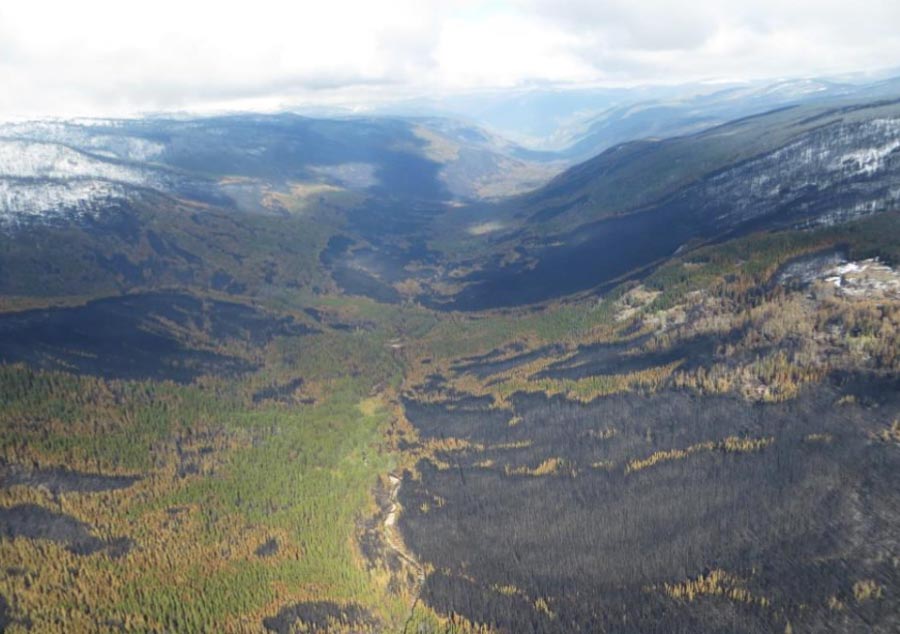
Researchers studying how wildfires have burned at a particular location found that subsequent fires have a “memory” that helped to self-regulate fire sizes and fire severity. When historical fires burned unabated, landscape patterns of surface and canopy fuels developed that provided barriers to future fire spread. Those same barriers can continue to influence the spread of additional fires.
Susan Prichard and Paul Hessburg were the principal investigators on the “Reburn Project” for the Joint Fire Science Program. They developed a paper, “Evaluating the influence of prior burn mosaics on subsequent wildfire behavior, severity, and fire management options”.
Here are some additional highlights from their findings:
The Reburn Project was motivated by a need to better understand wildfires as fuel reduction treatments and to assess the impacts of decades of wildland fire suppression activities on forested landscapes. The study examined three areas, located in the inland Pacific Northwest, central Idaho and interior British Columbia. Each area had experienced a recent large wildfire event in montane forests.
Reburn Highlights
- Past wildfires generally mitigate burn severity for a time, even under extreme fire weather conditions that are associated with large fires.
- Since around 1900-1934, fire suppression and not wildfire has been a primary influence on forest and fuel succession. Quantifying the effects of fire suppression on particular landscapes is difficult given the long history and its prevalence across the region. Results from simulation modeling have the potential to illustrate in compelling ways the combined effects of removing fires from landscapes that experienced variable fire severity and spatial extent.
- The researchers developed a state-transition model that allowed them to simulate the growth and potential severity 20th century ignitions that were suppressed. Fire growth simulations were modeled using the daily meteorology available at the time of the ignitions and the FSPro model. The researchers found that the simulated landscapes were reburn landscapes; i.e., the complexity of forest seral stage conditions and fuelbeds was an emergent property of successive reburning over the centuries, and fuel succession explained most of the severity patterns observed.
- Modern-day fire suppression scenarios led to “boom and bust” landscapes, where continuous mature forests developed, that were capable of supporting large fire spread, and were eventually burned with mostly high severity. However, using a variety of historical landscape conditions as an initial basis, in scenarios where most or all fires were allowed to burn, fine- to meso-grained patchworks resulted, and they provided a highly diverse range of habitats and values over time, and landscapes were much less susceptible to large, high severity events. Instead, more typical fire size distributions and more characteristic variation in fire severity were restored.

Nothing new here.
Instead of looking at models go look at the real thing
Let’s put emphasis into getting some utility from our exspensive $$ effort in suppression.
Let’s maintain the fuel breaks and fire lines we build on fires so we can use them
On the next fire.
I know of several events where this has happened.
Let’s get our agencies the program emphasis and funds they need to do this.
I’m not sure that anthropomorphizing wildfire (ex. has memory, self regulating) really does justice to this research and the discussion of it. It’s pretty obvious that past fires, or the lack thereof, affect future fire intensity. The questions become to what degree are those effects affected by human actions such as development, use (ex. logging), wildfire management and suppression, and controlled burning.
Seems like just another article by the ” let burn ” group of so -called scientists ?
Using terms like “MEMORY AND SELF REGULATION ” seems over the top . A simulation model is just that ;perhaps an educated guess ! .There is no doubt that an area once burned ,will not usually burn ,however this does not seem like new information.
This research money could be better spent by purchasing more Firefighting Aircraft .